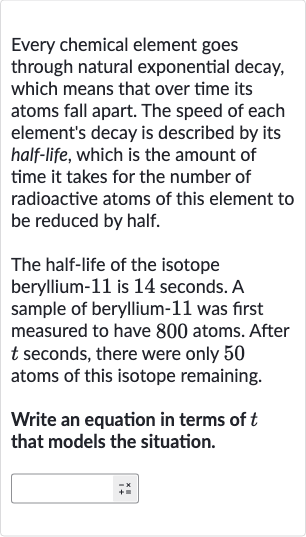AI tutor
Welcome to Bytelearn!
Let’s check out your problem:

Every chemical element goes through natural exponential decay, which means that over time its atoms fall apart. The speed of each element's decay is described by its half-life, which is the amount of time it takes for the number of radioactive atoms of this element to be reduced by half.The half-life of the isotope beryllium- is seconds. A sample of beryllium- was first measured to have atoms. After seconds, there were only atoms of this isotope remaining.Write an equation in terms of that models the situation.
Full solution
Q. Every chemical element goes through natural exponential decay, which means that over time its atoms fall apart. The speed of each element's decay is described by its half-life, which is the amount of time it takes for the number of radioactive atoms of this element to be reduced by half.The half-life of the isotope beryllium- is seconds. A sample of beryllium- was first measured to have atoms. After seconds, there were only atoms of this isotope remaining.Write an equation in terms of that models the situation.
- Rephrase the Question: First, let's rephrase the "What is the exponential decay equation that models the reduction of beryllium atoms from to over time , given its half-life of seconds?"
- Identify Quantities: Identify the initial quantity and the remaining quantity after time .Initial quantity : atomsRemaining quantity : atoms
- Determine Half-life: Determine the half-life of the substance.Half-life of beryllium: seconds
- Calculate Decay Factor: Since the half-life is the time it takes for a substance to reduce to half its initial amount, the decay factor can be calculated using the formula , where is the half-life.Calculate the decay factor for beryllium.
- Write Decay Equation: Perform the calculation for the decay factor . (rounded to four decimal places for simplicity)
- Solve for Remaining Atoms: Now, we can write the exponential decay equation in the form , where is the remaining quantity after time , is the initial quantity, and is the decay factor.Substitute the values for and into the equation.
- Take Natural Logarithm: To find the time when there are only atoms remaining, we need to solve the equation . Take the natural logarithm of both sides to solve for .
- Simplify Equation: Apply the properties of logarithms to simplify the equation.
- Isolate Variable: Isolate on one side of the equation.
- Calculate Time: Perform the calculation to find the value of .
seconds
More problems from Write exponential functions: word problems
QuestionGet tutor help
QuestionGet tutor help
QuestionGet tutor help
QuestionGet tutor help
QuestionGet tutor help
QuestionGet tutor help
QuestionGet tutor help
QuestionGet tutor help
QuestionGet tutor help
